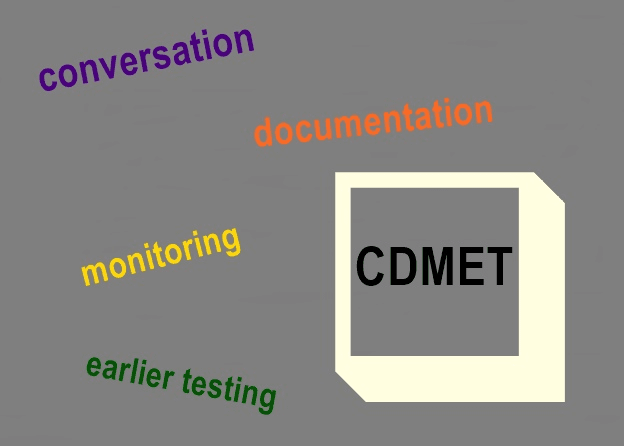CDMET is a mnemonic which name is an abbreviation that stands for Conversation, Documentation, Monitoring, Earlier Testing. These clusters can include different test charters which help to organize the exploratory testing process.
Let’s analyze each the component separately.

CDMET mnemonic
Conversation
Conversation is all forms of communication among people in the office. It can range from daily conversations in the corporate kitchen to regular meetings where current testing cases are discussed.
One way or another, but you need to communicate with people who are involved in the testing process:
- Different departments: business, development, marketing;
- Programmers, system architects, and web security engineers;
- Potential users, customers, and managers.
It will be useful to make notes during such conversations:
- Task planning;
- Grooming meeting;
- Debriefing;
- Product demo, training courses;
- Status meetings with the client, conducting different workshops regarding risks.
Documentation
Documents are everything documented including program code of a product. There are a lot of official specifications that can be used in your work. But don’t limit yourself to them only. You can also use emails, corporate chats, client documentation, etc.
Among all the many documents, it’s worth highlighting the following groups of papers:
- Official documents: requirement document, use cases, client business cases, UX designs, description of parameters, customer journey.
- Technical documents: class diagrams, program code, description of available graphical interfaces, web sequence diagrams.
- General project documentation: wiki, corporate chat logs, risk descriptions, meeting protocols.
- Test documentation: defect descriptions, test notes, automation scripts, program code, system reports.
- Client documentation: software manuals, training documents, release notes, FAQs, marketing campaigns.
Monitoring
Monitoring includes everything that, in one way or another, relates to the actual use of the web product. This is an essential basis for the development of new test charters.
- Technical monitoring: bug reports (generated by all departments of your software testing company), server logs, response times.
- User monitoring: statistic on the use of features, turnover of connected advertising, feedback from users.
Earlier testing
Earlier testing is very useful to properly develop strategies to further software testing. In fact, it tells you to use what you know yesterday so that you see what you have to deal with today.
If you do everything the right way, the early testing will easily merge with some other clusters, as you need to write down your checks, and tell your team about them.
- Outcomes and artifacts: reports of test cases done, test notes, defect descriptions, debriefs;
- Suspicions and residuals: list of known defects, unrecoverable errors, other unfinished business.










Leave A Comment